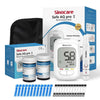What is the difference between type 1 and type 2 diabetes
-
Published on
Last updated on

Diabetes is a long-lasting disease that alters the modes of how your body utilizes the single biggest source of energy i.e. glucose. The result of these alterations is that the glucose remains inside the blood and is not being used by the body cells for energy. Due to this, the levels of glucose inside the blood remain too high, initiating desirable effects to various organs of the body. The ways of alteration of glucose metabolism vary according to the type of diabetes.
Diabetes is mainly classified based on the primary defect. Either the body cannot make enough insulin to lower the excess glucose in the blood, or the insulin effect on the body cells is lost despite normal levels of insulin.
In this type of diabetes, the body loses the ability to form enough insulin. Insulin is a hormone secreted by the pancreas that acts on muscles, liver, and fat to pick up/utilize glucose present in the blood so that normal levels of glucose are maintained inside the blood. This type of diabetes occurs in several diseased states and it usually occurs at a young age (mostly before 30 years).
In this type, the body’s immune system gets hyperactive and starts destroying pancreatic cells which make insulin. These diseases are called autoimmune diseases, for example, autoimmune thyroid disorders, celiac disease, and autoimmune gastritis.
The disease doesn't affect the insulin sensitivity of the cells; rather it affects the amount of insulin needed to control the excessively rising levels of glucose after the person takes any high-caloric meal. Thus the insulin sensitivity remains high but its levels are low. The classic signs and symptoms of more hunger, thirst, urination, and weight loss occur more often in this type of diabetes.
The classic hyperglycemic emergency includes diabetic ketoacidosis, which is a complex disorder that causes low blood pH, high ketone levels in blood and urine, severe dehydration, nausea, vomiting, abdominal cramps, and mood change. It can also cause life-threatening heart conduction problems due to potassium depletion.
The only treatment for this type of diabetes is to compensate for insulin deficiency. Various forms of insulin are available in the market, classified upon their duration of action. These are rapid-acting, short-term, intermediate-acting, and long-term insulin. Insulin is majorly given through the subcutaneous route, although intravenous injections are also given in case of hyperglycemic emergency.
This type of diabetes has a different etiology than type 1. It occurs due to insulin resistance in insulin-dependent organs. Insulin-dependent glucose transport doesn't occur, causing blood glucose levels to remain high even in the fasting state. Insulin resistance occurs classically in obesity. Thus obesity is a major risk factor only in type 2 diabetes.
This type of diabetes occurs in old ages (after 40). Genetic predisposition in this type is relatively stronger than in type 1. Due to multiple phenomena, older age with obesity progressively leads to the development of insulin resistance in organs. The body thinks that there's not enough insulin being secreted by the pancreas. So it starts overproducing insulin and insulin level in the blood rises in the initial stages. But, as there's no insulin effect, the overburdening of pancreatic cells ultimately leads to beta-cell failure. As a result, insulin levels fall in later stages.
Insulin sensitivity in this type of diabetes is low. On top of all, this type of diabetes slowly deteriorates every metabolic process silently because the classic symptoms of increased hunger, thirst, and urination are uncommon.
Hyperglycemic emergency in this type of diabetes includes hyperosmolar-hyperglycemic-state which is manifested by >600mg/dL blood glucose levels, massive dehydration, increased thirst and urination, seizures, and finally coma. There is no acidosis in this state.
As the primary defect is decreased insulin sensitivity, giving insulin as a treatment will yield no major benefit. The primary treatment aims at lowering blood glucose levels by increasing insulin sensitivity. It can be achieved by exercise, blood glucose-lowering/removing drugs, and insulin-sensitizing drugs.
CLASSIFICATION
Diabetes is mainly classified based on the primary defect. Either the body cannot make enough insulin to lower the excess glucose in the blood, or the insulin effect on the body cells is lost despite normal levels of insulin.
TYPE 1 DIABETES
In this type of diabetes, the body loses the ability to form enough insulin. Insulin is a hormone secreted by the pancreas that acts on muscles, liver, and fat to pick up/utilize glucose present in the blood so that normal levels of glucose are maintained inside the blood. This type of diabetes occurs in several diseased states and it usually occurs at a young age (mostly before 30 years).
In this type, the body’s immune system gets hyperactive and starts destroying pancreatic cells which make insulin. These diseases are called autoimmune diseases, for example, autoimmune thyroid disorders, celiac disease, and autoimmune gastritis.
The disease doesn't affect the insulin sensitivity of the cells; rather it affects the amount of insulin needed to control the excessively rising levels of glucose after the person takes any high-caloric meal. Thus the insulin sensitivity remains high but its levels are low. The classic signs and symptoms of more hunger, thirst, urination, and weight loss occur more often in this type of diabetes.
The classic hyperglycemic emergency includes diabetic ketoacidosis, which is a complex disorder that causes low blood pH, high ketone levels in blood and urine, severe dehydration, nausea, vomiting, abdominal cramps, and mood change. It can also cause life-threatening heart conduction problems due to potassium depletion.
The only treatment for this type of diabetes is to compensate for insulin deficiency. Various forms of insulin are available in the market, classified upon their duration of action. These are rapid-acting, short-term, intermediate-acting, and long-term insulin. Insulin is majorly given through the subcutaneous route, although intravenous injections are also given in case of hyperglycemic emergency.
TYPE 2 DIABETES
This type of diabetes has a different etiology than type 1. It occurs due to insulin resistance in insulin-dependent organs. Insulin-dependent glucose transport doesn't occur, causing blood glucose levels to remain high even in the fasting state. Insulin resistance occurs classically in obesity. Thus obesity is a major risk factor only in type 2 diabetes.
This type of diabetes occurs in old ages (after 40). Genetic predisposition in this type is relatively stronger than in type 1. Due to multiple phenomena, older age with obesity progressively leads to the development of insulin resistance in organs. The body thinks that there's not enough insulin being secreted by the pancreas. So it starts overproducing insulin and insulin level in the blood rises in the initial stages. But, as there's no insulin effect, the overburdening of pancreatic cells ultimately leads to beta-cell failure. As a result, insulin levels fall in later stages.
Insulin sensitivity in this type of diabetes is low. On top of all, this type of diabetes slowly deteriorates every metabolic process silently because the classic symptoms of increased hunger, thirst, and urination are uncommon.
Hyperglycemic emergency in this type of diabetes includes hyperosmolar-hyperglycemic-state which is manifested by >600mg/dL blood glucose levels, massive dehydration, increased thirst and urination, seizures, and finally coma. There is no acidosis in this state.
As the primary defect is decreased insulin sensitivity, giving insulin as a treatment will yield no major benefit. The primary treatment aims at lowering blood glucose levels by increasing insulin sensitivity. It can be achieved by exercise, blood glucose-lowering/removing drugs, and insulin-sensitizing drugs.
| Type 1 Diabetes | Type 2 Diabetes | |
| Primary cause | Decreased insulin production | Decreased insulin sensitivity |
| Onset | Young age | Old age |
| Genetic predisposition | Uncommon | More common |
| Insulin levels in the blood | Low | At first high, then low |
| Classic symptoms of hunger, thirst, urination | Common | Uncommon |
| Emergency state | Diabetic-ketoacidosis | Hyperosmolar-hyperglycemic-state |
| Association with obesity | No | Yes |
| Primary treatment | Insulin | Lifestyle changes, insulin-sensitizing and glucose-lowering drugs |





